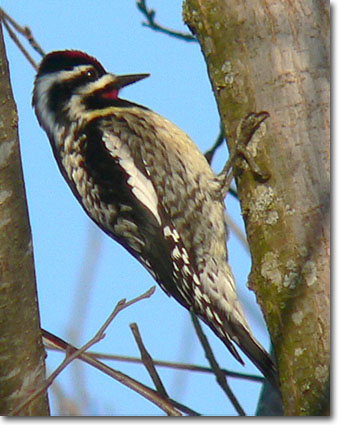A few weeks ago my wife Melissa had an immature Yellow-bellied Sapsucker (Sphyrapicus varius) hit her office window (NW 63rd & Classen). The bird jumped to a nearby tree branch, stunned but apparently none the worst for wear—many birds are not so

lucky. Although “yellow-bellied sapsucker” is sometimes tossed around as a joke among non-birders, the species is quite real and very interesting. It derives the “sapsucker” name from its habit of drilling small holes into the bark of living trees, and then returning later to drink the sap that flows from these holes; and it does have a yellowish belly although often this cannot be seen too well—among tree shadows and limbs—as the bird clings to a tree.
A full adult male has a red cap and throat, along with black and white plumage on much of the rest of the body. Females are similar, but have red only on their foreheads; young birds have brownish on much of the upper body. But the mark that most birders look for, I suspect, and present in all plumages, is the longitudinal white stripe in the middle of the black wing, a diagnostic point among woodpeckers normally found in our area (the Red-headed Woodpecker has longitudinal white on the lower half of the wing). This white streak of the sapsucker is one of those marks that lets a person say, “Ahhh, I know what this woodpecker is.”
Bent (Life Histories of North American Woodpeckers, 1964 reprint edition) related that McAtee, in a 1911 publication, stated that “…the yellow-bellied sapsucker attacks no fewer than 246 species of native trees and 6 vines, besides 31 kinds of introduced trees. Twenty-nine of these trees and 1 vine are known to be sometimes killed and 28 others are much disfigured or seriously reduce in vitality.” Because we have a reasonably low population of this woodpecker during migration and winter, timber in our area does not seem to be too adversely affected. Besides sap, sapsuckers supplement their diet with insects such as ants, beetles and wasps, some of which get caught in the flowing sap at tapholes. They also supplement their diet with nuts and berries.
Bent (1964), also related information from Bolles, taken from an 1892 publication, who raised 3 young sapsuckers in captivity: “They subsisted almost entirely on maple syrup and water in equal parts, fed by hand at first, but in a few days they drank readily from a basin.” Each consumed about 8 teaspoonfuls of syrup per day. Unfortunately, these 3 young, captured July 7, lived only a little over 3 months in captivity before they died, so there apparently were some diet problems in holding the birds so long in captivity; the autopsied birds showed abnormalities in the liver.
The Yellow-bellied Sapsucker migrates through Oklahoma and some of them remain in the state for the winter. On Christmas Bird Counts, from 1940 to 2009 the number of sapsuckers seen per party hour for the entire U.S has risen from about 0.025 birds/party hr. to about 0.075 birds/party hr; numbers for Oklahoma, from 1952-2009, average about 0.125 sapsuckers/party hr.; and numbers from 1952-2009 on the Oklahoma City CBC average about 0.04 birds/party hour, or about 1 sapsucker for every 25 party hours of field time (this is a good illustration of why knowing approximate party hours are important data on CBCs) (above data from Audubon Society CBC results).
Years ago, Hubert Harris, a club member, banded a Yellow-bellied Sapsucker in Oklahoma City and it showed up several days later (5 I think) in Redwing, Minnesota, a distance of some 550 air miles. Bird band returns from areas other than at and near the banding site are very rare, so the sapsucker Hubert banded told an interesting story of a bird moving hundreds of miles north-northeast in the span of a few days.
